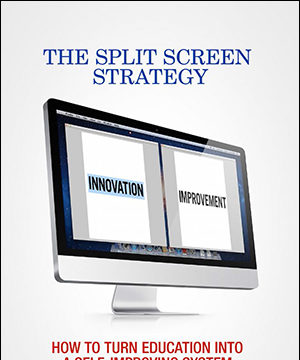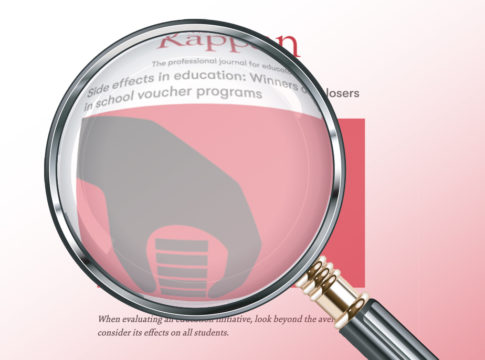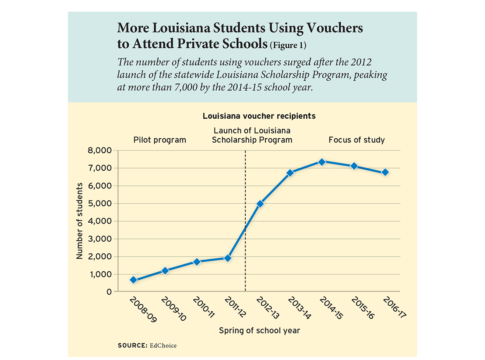 The School Choice Journey: School Vouchers and the Empowerment of Urban Families
The School Choice Journey: School Vouchers and the Empowerment of Urban Families
by Thomas Stewart and Patrick J. Wolf with a Foreword by Joe Lieberman
Palgrave Macmillan, 2014, $90.25; 217 pages.
As reviewed by Gerard Robinson
The nation’s capital became the epicenter for the private school choice battle in 2004 when President George W. Bush signed the District of Columbia School Choice Incentive Act, which created the Opportunity Scholarship Program. With support from the Washington Scholarship Fund, the program awards lower-income families with children enrolled in “schools in need of improvement” a scholarship to attend a private school. The initial award maximum was $7,500 per student. In 2014–15, the scholarship amount is $12,572 for enrollment at high schools and $8,381 for elementary and middle schools.
Elsewhere, Stewart and Wolf have estimated the impacts of the D.C. scholarships on student test scores and high-school graduation rates. Their goal for this book is to identify how 110 diverse urban families navigate the political waters of “choosing.” Based on data gathered from focus groups, personal interviews, electronic polling, and voucher program and school personnel between fall 2004 and spring 2008, Stewart and Wolf find that “parental school choice is not so much a destination; it is a journey.”
The authors describe a transition from clientism to consumerism to citizenship. Their logic is as follows: as clients, lower-income families annually accept public goods such as health care and education and have a minimal voice in how these are administered. With a voucher in hand to shop for a school beyond their neighborhood boundary, lower-income families’ voices begin to shape the delivery of education, and they become consumers. Once lower-income families engage in political activity to protect and advance the choice program, they move into active citizenship.
Stewart and Wolf offer real-world narratives about why and how lower-income families make this transition. A story may feature a Latino mother who had to learn English at night with support from a dictionary to help her daughter do homework; an East African family who chose one school because it offered multiple languages; or a Christian man who wanted religion to be part of his child’s learning experience. With a scholarship, these lower-income families venture into the private school sphere with confidence that wherever their children land it will not be worse than the school left behind. This is the case even if the chosen private school is not aligned specifically with a family’s religion, educational philosophy, or price tag. In other words, voucher families gained access to safe, academically diverse private schools, among them schools that children of members of Congress and the Washington, D.C. elite attend. And contrary to political rhetoric, Stewart and Wolf find that “competition” and “failing schools” are not the themes families expressed when asked why they enrolled in the scholarship program. Those themes float in a harbor where the rest of us fish.
Stewart and Wolf acknowledge the challenges associated with families’ shift to consumerism. Namely, consumer behavior in the Washington, D.C., private school marketplace is not uniform. Some parents, for example, visited private schools to see if they were a good curricular fit for their child. Others did not. Some parents read a school’s FAQ sheet to see what sports were offered. Others enrolled a child in a private school only to pull him or her out because team sports were not offered. Some private school administrators and teachers were welcoming to scholarship families; others were not. Some schools even threatened to revoke a child’s scholarship for misbehavior. Frankness about lower-income families’ transition to consumerism is often missing from voucher marketing campaigns or, at the other extreme, overrepresented by voucher opponents eager to trumpet the evils of privatization. Stewart and Wolf are straightforward about the journey. Their account is informed by rich qualitative data from the source that is infrequently tapped, yet matters most: families with children in the program.
Stewart and Wolf find in D.C. scholarship families’ shift to consumerism widely varying degrees of parental participation. A single parent with a supportive network is more likely than one without to display parental engagement, defined as helping a child with homework as well as enlisting in PTA and campus-based events that benefit the entire school. Parental involvement, by comparison, is defined as helping a child with homework or other activities while abstaining from organizational and campus-based events that benefit the entire school. Parents cite employment responsibilities and time allotted for campus-based events as reasons for non-engagement. Stewart and Wolf do not claim that a single parent without a support network is incapable of moving from involvement to engagement status. Many D.C. scholarship parents do so each school semester. Nevertheless, family structure and access to networks do matter to parental participation levels.
Stewart and Wolf assume that scholarship families’ journey to active citizenship is the road less traveled. Why? For one reason, 70 percent of families were not politically engaged before joining the program. And if we accept research that finds lower-income families participate in political activities at a rate lower than middle-income families, we should not expect a drastic change in political behavior by D.C. scholarship families. Events in 2009 provide an example. Only when the Obama administration and members of Congress threatened to end the D.C. scholarship program did parents and students engage in political activity. Prior to this threat, evidence from family evaluations between 2004 and 2008 confirm that active citizenship was the road less traveled. This raises some important questions.
Why weren’t D.C. parents ready to fight for the scholarship program from day one, given that the legislation passed out of the House of Representatives by just one vote? Or given the blistering criticism heaped upon the program in the Washington Post, blogs, and other media outlets by leadership in teachers unions and the Congressional Black Caucus? Did not the defeat or retirement of key Washington, D.C., stakeholders in the mayor’s office, or on the city council and school board, raise concern among participating families? I am sure it did. But concern did not evolve into organized political action. Parents were surprised when faced with the expectation that they would actively fight for the program:
When asked what kinds of public expressions of support parents would be willing to make, most focus group participants said that they preferred to write letters and testify before Congress or the city council rather than participate in other forms of expression like demonstrating and voting.
Stewart and Wolf conclude that not all families participating in the D.C. scholarship program “made the complete school choice journey from clients to savvy consumers to active and influential citizens.”
Here I disagree with the Stewart and Wolf assessment about the three-step journey. Voting and holding a “Save My School” sign at one-day rallies are important, yet they rank among the least telling indicators of families’ fidelity to the school choice journey. For the same reason that accepting a scholarship moved families from the object of a conversation to the subject of a conversation about educational opportunity, these same families’ decisions to leave one school and to keep their child enrolled in a school of their choice for as long as the option is available are, in my opinion, examples of “the complete school choice journey.” Not so if the focus is solely on civic barnstorming. Besides, who is the target audience for political action?
Rallies are important to funders. And philanthropy has sustained the parental school-choice movement to this day. But funding priorities change with new strategic plans while the school calendar ticks away. Voting is important to politicians. And if I may rely on what I have witnessed about school choice, it is safe to say that between 2004 and 2014, D.C. scholarship (and charter school) parents waited in line to enroll their children into a school of their choice with more regularity than they waited in line to vote for a Washington, D.C., official. Consequently, let us not judge families’ political tenacity by two- or four-year election cycles alone. Daily acts matter, too, because learning is important to families.
In conclusion, I believe D.C. scholarship families did reach each rung of the Stewart-Wolf transition from clientism to consumerism to citizenship. How? By “voting with their feet.”
Gerard Robinson is senior fellow at the CUNY Institute for Education Policy.





